lock CHEVROLET BLAZER 2002 2.G Owners Manual
[x] Cancel search | Manufacturer: CHEVROLET, Model Year: 2002, Model line: BLAZER, Model: CHEVROLET BLAZER 2002 2.GPages: 488, PDF Size: 2.95 MB
Page 9 of 488
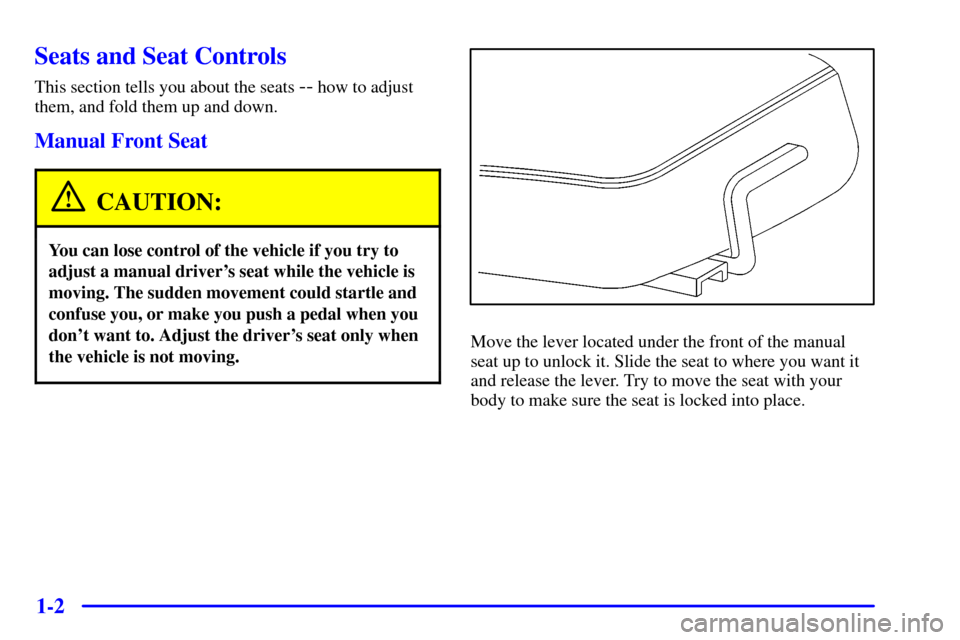
1-2
Seats and Seat Controls
This section tells you about the seats -- how to adjust
them, and fold them up and down.
Manual Front Seat
CAUTION:
You can lose control of the vehicle if you try to
adjust a manual driver's seat while the vehicle is
moving. The sudden movement could startle and
confuse you, or make you push a pedal when you
don't want to. Adjust the driver's seat only when
the vehicle is not moving.
Move the lever located under the front of the manual
seat up to unlock it. Slide the seat to where you want it
and release the lever. Try to move the seat with your
body to make sure the seat is locked into place.
Page 10 of 488
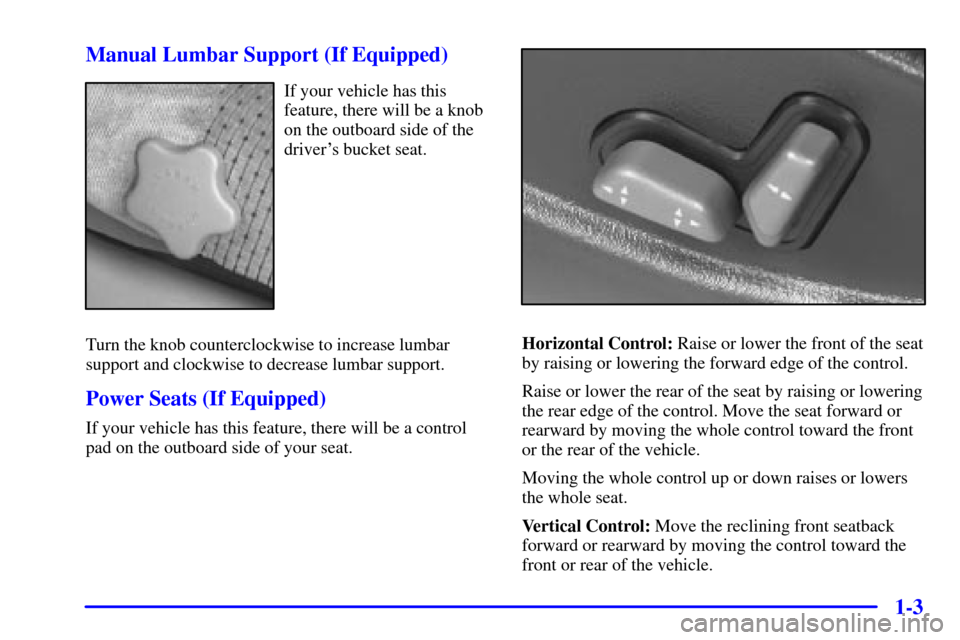
1-3 Manual Lumbar Support (If Equipped)
If your vehicle has this
feature, there will be a knob
on the outboard side of the
driver's bucket seat.
Turn the knob counterclockwise to increase lumbar
support and clockwise to decrease lumbar support.
Power Seats (If Equipped)
If your vehicle has this feature, there will be a control
pad on the outboard side of your seat.
Horizontal Control: Raise or lower the front of the seat
by raising or lowering the forward edge of the control.
Raise or lower the rear of the seat by raising or lowering
the rear edge of the control. Move the seat forward or
rearward by moving the whole control toward the front
or the rear of the vehicle.
Moving the whole control up or down raises or lowers
the whole seat.
Vertical Control: Move the reclining front seatback
forward or rearward by moving the control toward the
front or rear of the vehicle.
Page 12 of 488
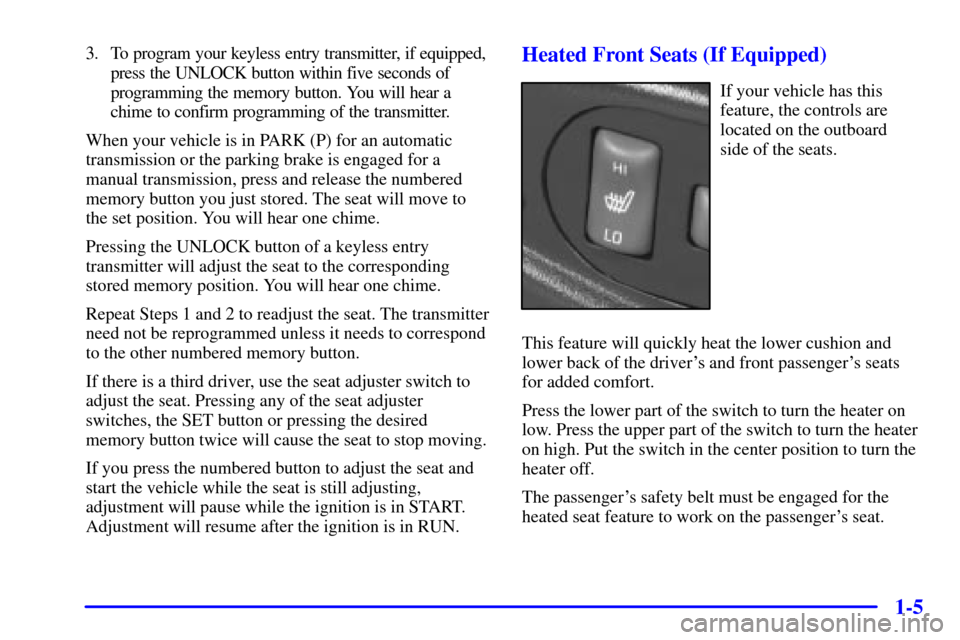
1-5
3. To program your keyless entry transmitter, if equipped,
press the UNLOCK button within five seconds of
programming the memory button. You will hear a
chime to confirm programming of the transmitter.
When your vehicle is in PARK (P) for an automatic
transmission or the parking brake is engaged for a
manual transmission, press and release the numbered
memory button you just stored. The seat will move to
the set position. You will hear one chime.
Pressing the UNLOCK button of a keyless entry
transmitter will adjust the seat to the corresponding
stored memory position. You will hear one chime.
Repeat Steps 1 and 2 to readjust the seat. The transmitter
need not be reprogrammed unless it needs to correspond
to the other numbered memory button.
If there is a third driver, use the seat adjuster switch to
adjust the seat. Pressing any of the seat adjuster
switches, the SET button or pressing the desired
memory button twice will cause the seat to stop moving.
If you press the numbered button to adjust the seat and
start the vehicle while the seat is still adjusting,
adjustment will pause while the ignition is in START.
Adjustment will resume after the ignition is in RUN.Heated Front Seats (If Equipped)
If your vehicle has this
feature, the controls are
located on the outboard
side of the seats.
This feature will quickly heat the lower cushion and
lower back of the driver's and front passenger's seats
for added comfort.
Press the lower part of the switch to turn the heater on
low. Press the upper part of the switch to turn the heater
on high. Put the switch in the center position to turn the
heater off.
The passenger's safety belt must be engaged for the
heated seat feature to work on the passenger's seat.
Page 13 of 488
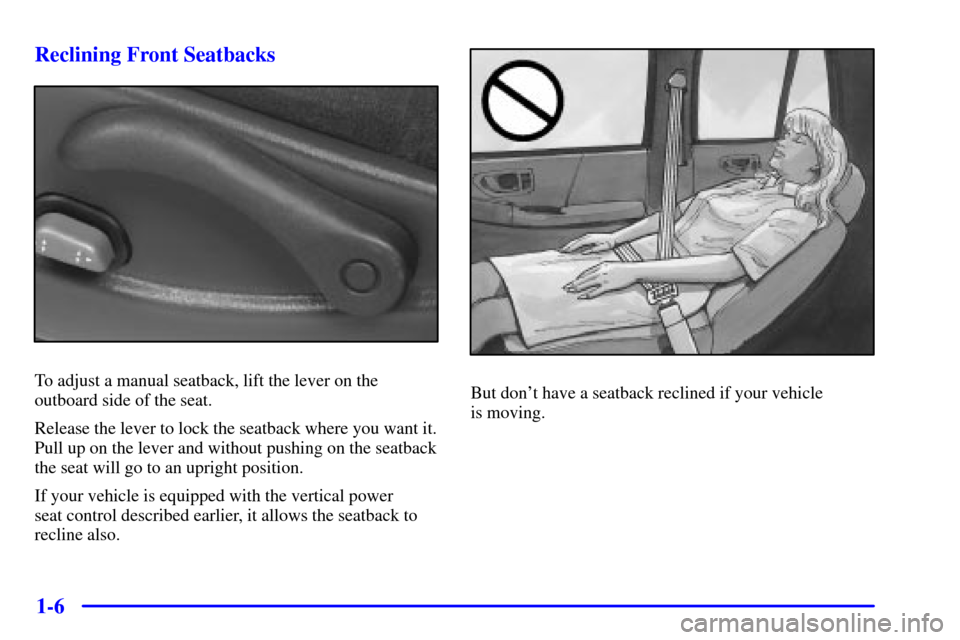
1-6 Reclining Front Seatbacks
To adjust a manual seatback, lift the lever on the
outboard side of the seat.
Release the lever to lock the seatback where you want it.
Pull up on the lever and without pushing on the seatback
the seat will go to an upright position.
If your vehicle is equipped with the vertical power
seat control described earlier, it allows the seatback to
recline also.But don't have a seatback reclined if your vehicle
is moving.
Page 15 of 488
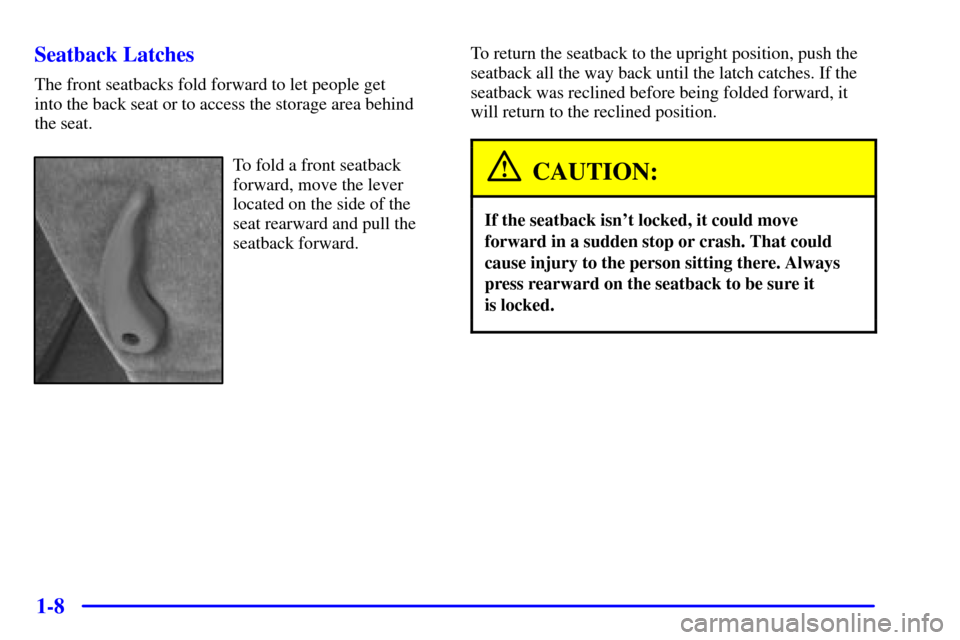
1-8 Seatback Latches
The front seatbacks fold forward to let people get
into the back seat or to access the storage area behind
the seat.
To fold a front seatback
forward, move the lever
located on the side of the
seat rearward and pull the
seatback forward.To return the seatback to the upright position, push the
seatback all the way back until the latch catches. If the
seatback was reclined before being folded forward, it
will return to the reclined position.CAUTION:
If the seatback isn't locked, it could move
forward in a sudden stop or crash. That could
cause injury to the person sitting there. Always
press rearward on the seatback to be sure it
is locked.
Page 16 of 488
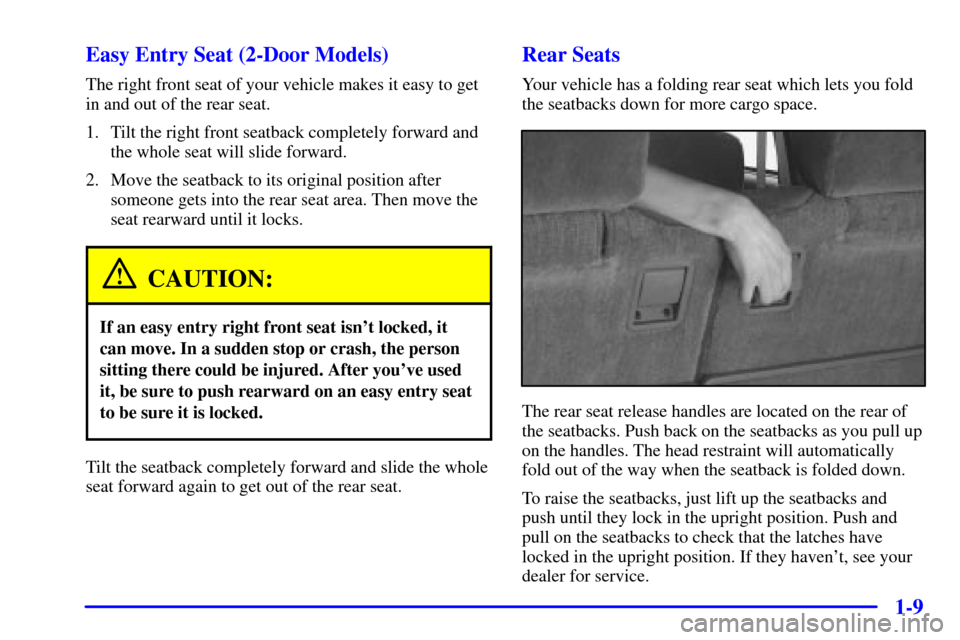
1-9 Easy Entry Seat (2-Door Models)
The right front seat of your vehicle makes it easy to get
in and out of the rear seat.
1. Tilt the right front seatback completely forward and
the whole seat will slide forward.
2. Move the seatback to its original position after
someone gets into the rear seat area. Then move the
seat rearward until it locks.
CAUTION:
If an easy entry right front seat isn't locked, it
can move. In a sudden stop or crash, the person
sitting there could be injured. After you've used
it, be sure to push rearward on an easy entry seat
to be sure it is locked.
Tilt the seatback completely forward and slide the whole
seat forward again to get out of the rear seat.
Rear Seats
Your vehicle has a folding rear seat which lets you fold
the seatbacks down for more cargo space.
The rear seat release handles are located on the rear of
the seatbacks. Push back on the seatbacks as you pull up
on the handles. The head restraint will automatically
fold out of the way when the seatback is folded down.
To raise the seatbacks, just lift up the seatbacks and
push until they lock in the upright position. Push and
pull on the seatbacks to check that the latches have
locked in the upright position. If they haven't, see your
dealer for service.
Page 17 of 488
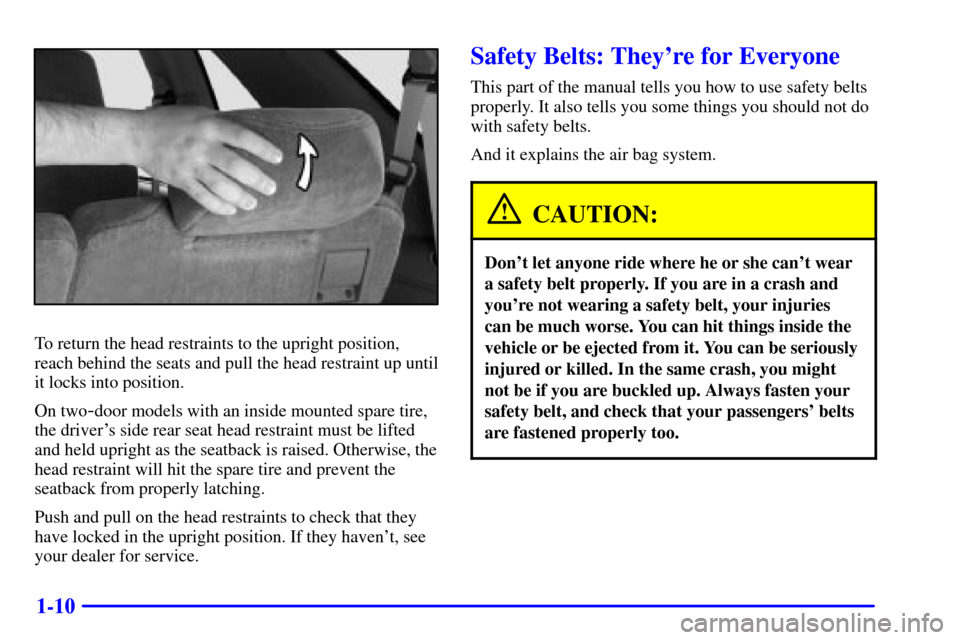
1-10
To return the head restraints to the upright position,
reach behind the seats and pull the head restraint up until
it locks into position.
On two
-door models with an inside mounted spare tire,
the driver's side rear seat head restraint must be lifted
and held upright as the seatback is raised. Otherwise, the
head restraint will hit the spare tire and prevent the
seatback from properly latching.
Push and pull on the head restraints to check that they
have locked in the upright position. If they haven't, see
your dealer for service.
Safety Belts: They're for Everyone
This part of the manual tells you how to use safety belts
properly. It also tells you some things you should not do
with safety belts.
And it explains the air bag system.
CAUTION:
Don't let anyone ride where he or she can't wear
a safety belt properly. If you are in a crash and
you're not wearing a safety belt, your injuries
can be much worse. You can hit things inside the
vehicle or be ejected from it. You can be seriously
injured or killed. In the same crash, you might
not be if you are buckled up. Always fasten your
safety belt, and check that your passengers' belts
are fastened properly too.
Page 23 of 488
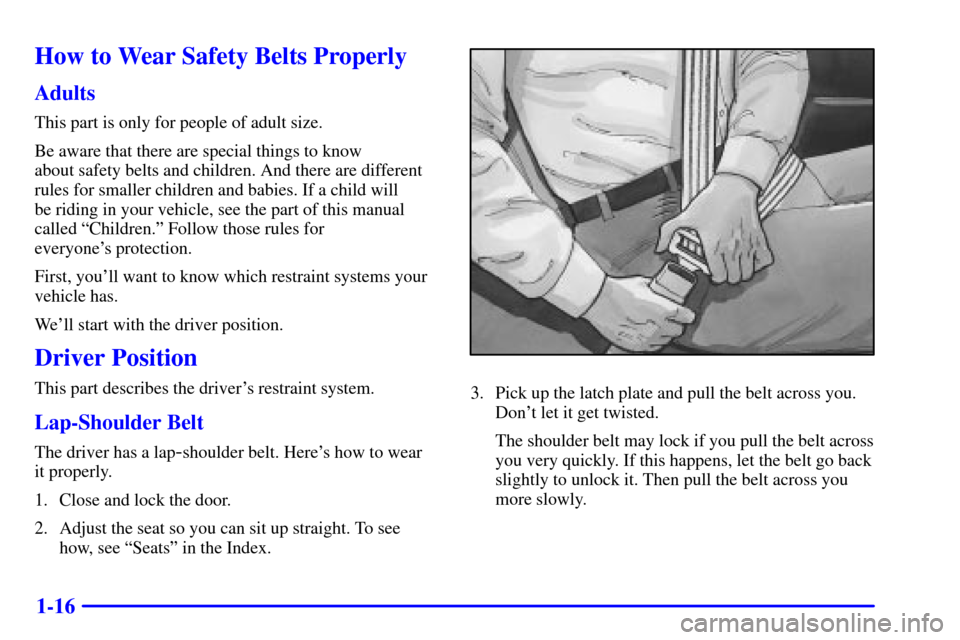
1-16
How to Wear Safety Belts Properly
Adults
This part is only for people of adult size.
Be aware that there are special things to know
about safety belts and children. And there are different
rules for smaller children and babies. If a child will
be riding in your vehicle, see the part of this manual
called ªChildren.º Follow those rules for
everyone's protection.
First, you'll want to know which restraint systems your
vehicle has.
We'll start with the driver position.
Driver Position
This part describes the driver's restraint system.
Lap-Shoulder Belt
The driver has a lap-shoulder belt. Here's how to wear
it properly.
1. Close and lock the door.
2. Adjust the seat so you can sit up straight. To see
how, see ªSeatsº in the Index.
3. Pick up the latch plate and pull the belt across you.
Don't let it get twisted.
The shoulder belt may lock if you pull the belt across
you very quickly. If this happens, let the belt go back
slightly to unlock it. Then pull the belt across you
more slowly.
Page 24 of 488
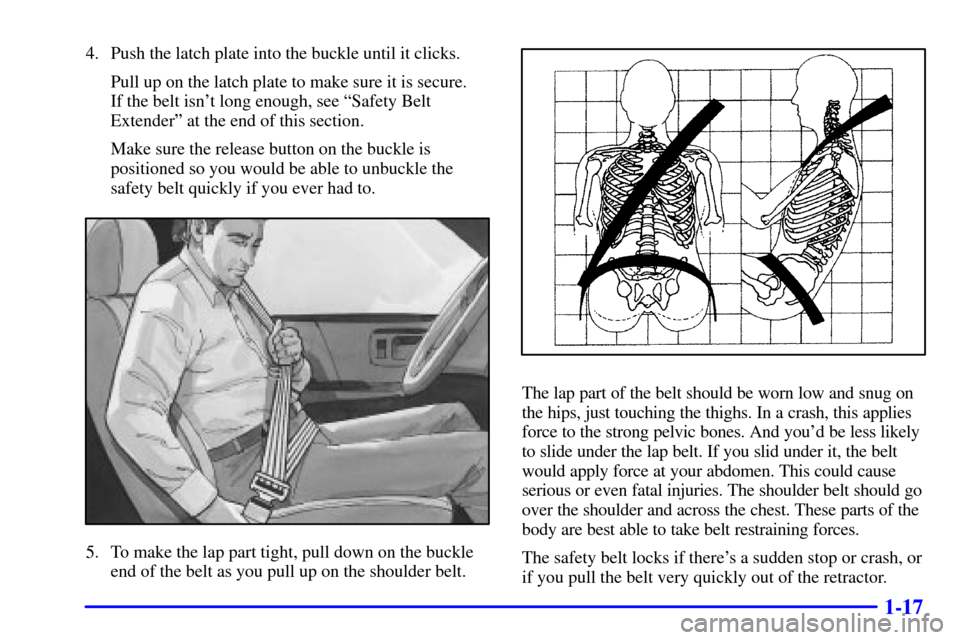
1-17
4. Push the latch plate into the buckle until it clicks.
Pull up on the latch plate to make sure it is secure.
If the belt isn't long enough, see ªSafety Belt
Extenderº at the end of this section.
Make sure the release button on the buckle is
positioned so you would be able to unbuckle the
safety belt quickly if you ever had to.
5. To make the lap part tight, pull down on the buckle
end of the belt as you pull up on the shoulder belt.
The lap part of the belt should be worn low and snug on
the hips, just touching the thighs. In a crash, this applies
force to the strong pelvic bones. And you'd be less likely
to slide under the lap belt. If you slid under it, the belt
would apply force at your abdomen. This could cause
serious or even fatal injuries. The shoulder belt should go
over the shoulder and across the chest. These parts of the
body are best able to take belt restraining forces.
The safety belt locks if there's a sudden stop or crash, or
if you pull the belt very quickly out of the retractor.
Page 30 of 488
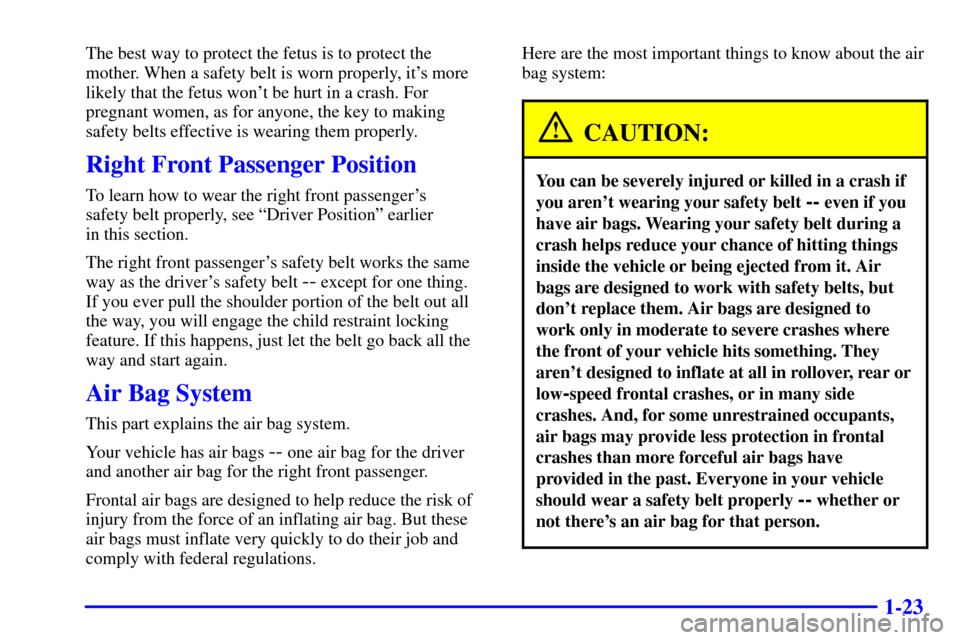
1-23
The best way to protect the fetus is to protect the
mother. When a safety belt is worn properly, it's more
likely that the fetus won't be hurt in a crash. For
pregnant women, as for anyone, the key to making
safety belts effective is wearing them properly.
Right Front Passenger Position
To learn how to wear the right front passenger's
safety belt properly, see ªDriver Positionº earlier
in this section.
The right front passenger's safety belt works the same
way as the driver's safety belt
-- except for one thing.
If you ever pull the shoulder portion of the belt out all
the way, you will engage the child restraint locking
feature. If this happens, just let the belt go back all the
way and start again.
Air Bag System
This part explains the air bag system.
Your vehicle has air bags
-- one air bag for the driver
and another air bag for the right front passenger.
Frontal air bags are designed to help reduce the risk of
injury from the force of an inflating air bag. But these
air bags must inflate very quickly to do their job and
comply with federal regulations.Here are the most important things to know about the air
bag system:
CAUTION:
You can be severely injured or killed in a crash if
you aren't wearing your safety belt
-- even if you
have air bags. Wearing your safety belt during a
crash helps reduce your chance of hitting things
inside the vehicle or being ejected from it. Air
bags are designed to work with safety belts, but
don't replace them. Air bags are designed to
work only in moderate to severe crashes where
the front of your vehicle hits something. They
aren't designed to inflate at all in rollover, rear or
low
-speed frontal crashes, or in many side
crashes. And, for some unrestrained occupants,
air bags may provide less protection in frontal
crashes than more forceful air bags have
provided in the past. Everyone in your vehicle
should wear a safety belt properly
-- whether or
not there's an air bag for that person.